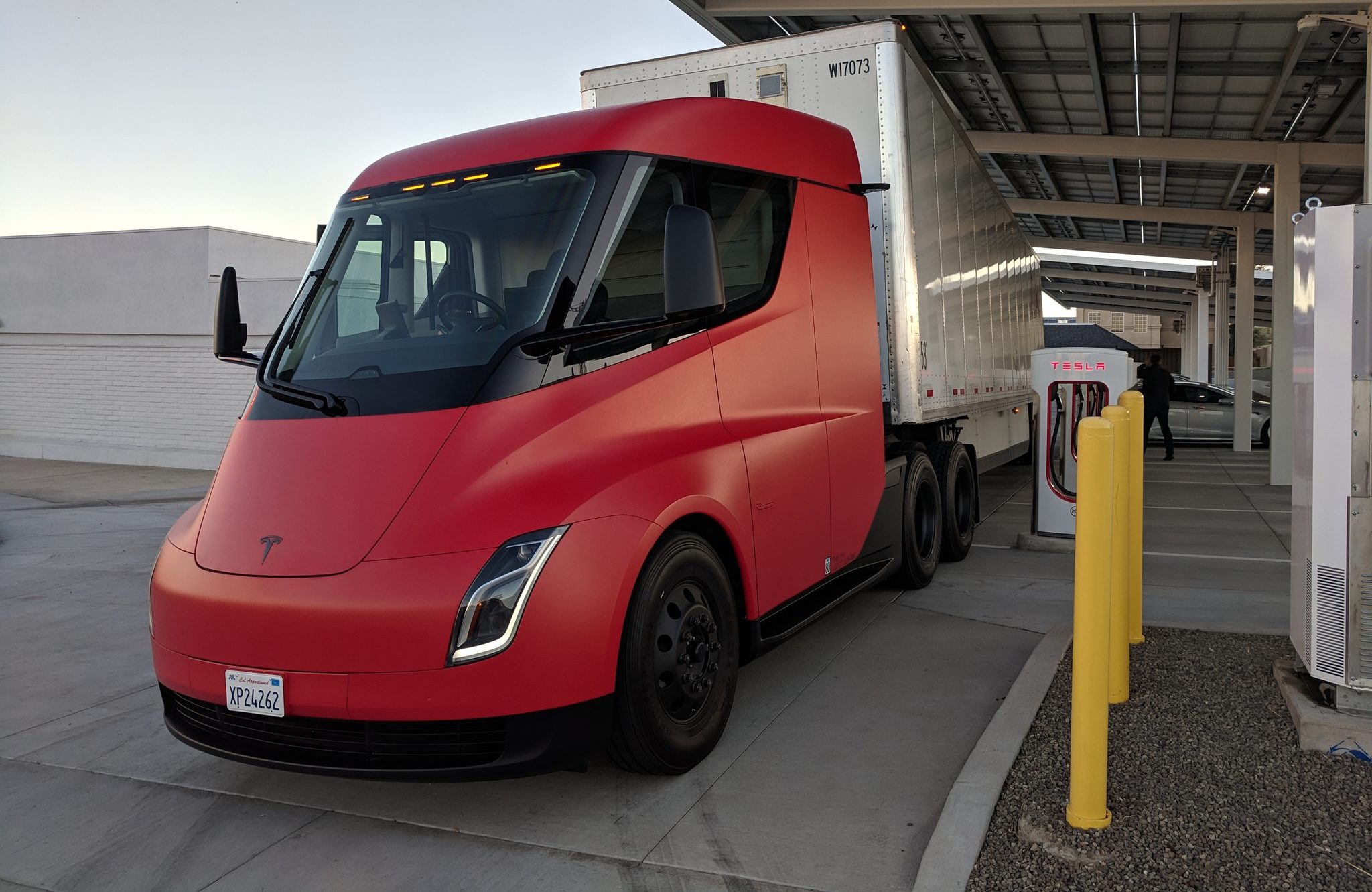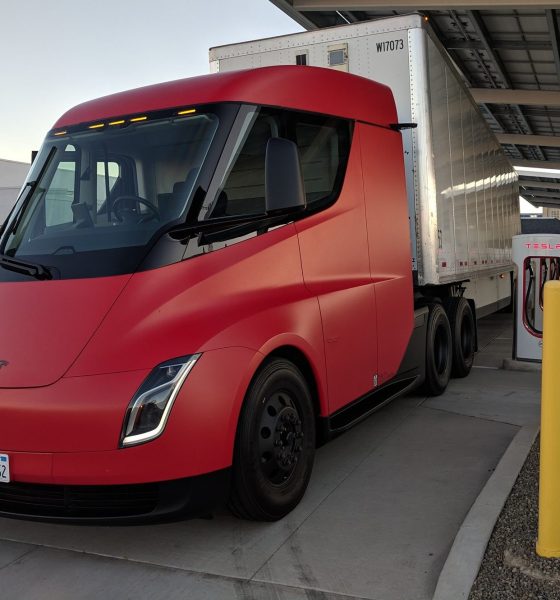

News
Tesla Semi-like aerodynamic trucks will be mandated in Europe to make roads safer
Trucks that look similar to the Tesla Semi will soon be the norm in Europe, with members of the European Parliament voting for a law that will require manufacturers to produce vehicles that are more aerodynamic and energy efficient. It is estimated that by adopting these changes, the region’s long-haul industry will produce less carbon dioxide, consume less fuel, and even save lives.
Under the regulations, truck makers will be allowed to lengthen the design of their vehicles’ cabs by up to 80-90 cm, provided that the extra space is utilized to provide drivers with better vision. Extending the cab will likely result in Europe’s next-generation trucks looking quite similar to the Tesla Semi, which features a large wraparound windshield that gives drivers a commanding view of the road and the vehicle’s surroundings.
These changes are expected to make trucks safer for the public, as the curved cabs could deflect pedestrian and cyclists during collissions in a safer way. Pedestrians that are hit by conventional, brick-shaped trucks run the risk of going under the vehicle’s wheels after the impact. This risk is significantly reduced in trucks that have more rounded edges in front.

The European Federation for Transport and Environment (also known as Transport and Environment or T&E) notes that Europe sees around 4,000 fatalities per year from truck-related incidents. From this number, around 1,000 are comprised of cyclists and pedestrians. James Nix, freight director at T&E, noted that the new law is ultimately a win for both the trucking industry and the public. “The truck of the future will be sleeker, reducing fuel bills and emissions. It will also be safer through better driver vision of cyclists and pedestrians in particular,” he said.
Apart from making long-haulers safer to the public, the shift to more aerodynamic truck designs is expected to reduce the industry’s carbon emissions by 7-10%. The reforms are also estimated to help reduce fuel bills by up to 5% in long-haul trucks and up to 10% in vehicles that are fitted with more advanced engines.
Europe’s aerodynamic trucks are expected to start getting deployed beginning September 2020, a target that has been met by a rather tepid response from the European Automobile Manufacturers Association. Before the proposal was confirmed by members of the European Parliament, the association proved quite skeptical of the initiative, stating that the redesigned vehicles will likely not be ready for the 2020 goal, as noted by The Irish Times.
This recent regulation, as well as the hesitation from the European Automobile Manufacturers Association, all but opens a large market for electric trucks like the Tesla Semi, which already conforms to the design suggested in the new regulations. Add the benefit of the Semi’s low operating cost and its zero-emissions due to its all-electric construction, and the vehicle all but becomes tailor-fit for Europe changing trucking market.
It’s not just Tesla that can take advantage of Europe’s new initiative, either, as companies like hydrogen-electric truck maker Nikola could also deploy its aerodynamic long-haulers like the Nikola One and Nikola Two to the region. Nevertheless, Nikola might need to revisit its plans for Europe, as the vehicle it created for the region, the Nikola Tre, features a conventional brick-like design.

News
Tesla FSD fleet is nearing 7 billion total miles, including 2.5 billion city miles
As can be seen on Tesla’s official FSD webpage, vehicles equipped with the system have now navigated over 6.99 billion miles.

Tesla’s Full Self-Driving (Supervised) fleet is closing in on almost 7 billion total miles driven, as per data posted by the company on its official FSD webpage.
These figures hint at the massive scale of data fueling Tesla’s rapid FSD improvements, which have been quite notable as of late.
FSD mileage milestones
As can be seen on Tesla’s official FSD webpage, vehicles equipped with the system have now navigated over 6.99 billion miles. Tesla owner and avid FSD tester Whole Mars Catalog also shared a screenshot indicating that from the nearly 7 billion miles traveled by the FSD fleet, more than 2.5 billion miles were driven inside cities.
City miles are particularly valuable for complex urban scenarios like unprotected turns, pedestrian interactions, and traffic lights. This is also the difference-maker for FSD, as only complex solutions, such as Waymo’s self-driving taxis, operate similarly on inner-city streets. And even then, incidents such as the San Francisco blackouts have proven challenging for sensor-rich vehicles like Waymos.
Tesla’s data edge
Tesla has a number of advantages in the autonomous vehicle sector, one of which is the size of its fleet and the number of vehicles training FSD on real-world roads. Tesla’s nearly 7 billion FSD miles then allow the company to roll out updates that make its vehicles behave like they are being driven by experienced drivers, even if they are operating on their own.
So notable are Tesla’s improvements to FSD that NVIDIA Director of Robotics Jim Fan, after experiencing FSD v14, noted that the system is the first AI that passes what he described as a “Physical Turing Test.”
“Despite knowing exactly how robot learning works, I still find it magical watching the steering wheel turn by itself. First it feels surreal, next it becomes routine. Then, like the smartphone, taking it away actively hurts. This is how humanity gets rewired and glued to god-like technologies,” Fan wrote in a post on X.
News
Tesla starts showing how FSD will change lives in Europe
Local officials tested the system on narrow country roads and were impressed by FSD’s smooth, human-like driving, with some calling the service a game-changer for everyday life in areas that are far from urban centers.

Tesla has launched Europe’s first public shuttle service using Full Self-Driving (Supervised) in the rural Eifelkreis Bitburg-Prüm region of Germany, demonstrating how the technology can restore independence and mobility for people who struggle with limited transport options.
Local officials tested the system on narrow country roads and were impressed by FSD’s smooth, human-like driving, with some calling the service a game-changer for everyday life in areas that are far from urban centers.
Officials see real impact on rural residents
Arzfeld Mayor Johannes Kuhl and District Administrator Andreas Kruppert personally tested the Tesla shuttle service. This allowed them to see just how well FSD navigated winding lanes and rural roads confidently. Kruppert said, “Autonomous driving sounds like science fiction to many, but we simply see here that it works totally well in rural regions too.” Kuhl, for his part, also noted that FSD “feels like a very experienced driver.”
The pilot complements the area’s “Citizen Bus” program, which provides on-demand rides for elderly residents who can no longer drive themselves. Tesla Europe shared a video of a demonstration of the service, highlighting how FSD gives people their freedom back, even in places where public transport is not as prevalent.
What the Ministry for Economic Affairs and Transport says
Rhineland-Palatinate’s Minister Daniela Schmitt supported the project, praising the collaboration that made this “first of its kind in Europe” possible. As per the ministry, the rural rollout for the service shows FSD’s potential beyond major cities, and it delivers tangible benefits like grocery runs, doctor visits, and social connections for isolated residents.
“Reliable and flexible mobility is especially vital in rural areas. With the launch of a shuttle service using self-driving vehicles (FSD supervised) by Tesla in the Eifelkreis Bitburg-Prüm, an innovative pilot project is now getting underway that complements local community bus services. It is the first project of its kind in Europe.
“The result is a real gain for rural mobility: greater accessibility, more flexibility and tangible benefits for everyday life. A strong signal for innovation, cooperation and future-oriented mobility beyond urban centers,” the ministry wrote in a LinkedIn post.
News
Tesla China quietly posts Robotaxi-related job listing
Tesla China is currently seeking a Low Voltage Electrical Engineer to work on circuit board design for the company’s autonomous vehicles.

Tesla has posted a new job listing in Shanghai explicitly tied to its Robotaxi program, fueling speculation that the company is preparing to launch its dedicated autonomous ride-hailing service in China.
As noted in the listing, Tesla China is currently seeking a Low Voltage Electrical Engineer to work on circuit board design for the company’s autonomous vehicles.
Robotaxi-specific role
The listing, which was shared on social media platform X by industry watcher @tslaming, suggested that Tesla China is looking to fill the role urgently. The job listing itself specifically mentions that the person hired for the role will be working on the Low Voltage Hardware team, which would design the circuit boards that would serve as the nervous system of the Robotaxi.
Key tasks for the role, as indicated in the job listing, include collaboration with PCB layout, firmware, mechanical, program management, and validation teams, among other responsibilities. The role is based in Shanghai.
China Robotaxi launch
China represents a massive potential market for robotaxis, with its dense urban centers and supportive policies in select cities. Tesla has limited permission to roll out FSD in the country, though despite this, its vehicles have been hailed as among the best in the market when it comes to autonomous features. So far, at least, it appears that China supports Tesla’s FSD and Robotaxi rollout.
This was hinted at in November, when Tesla brought the Cybercab to the 8th China International Import Expo (CIIE) in Shanghai, marking the first time that the autonomous two-seater was brought to the Asia-Pacific region. The vehicle, despite not having a release date in China, received a significant amount of interest among the event’s attendees.








